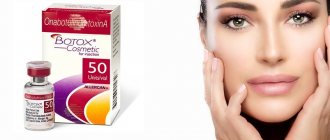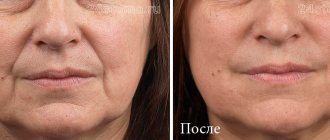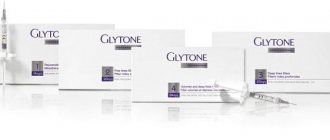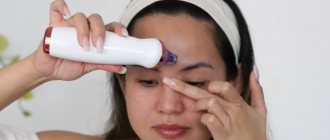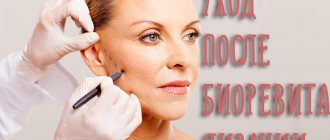Possible complications after filler injection
After the facial contouring procedure with fillers, the patient may experience swelling, redness of the skin, minor bruises and hematomas for several days. If the procedure was carried out correctly, these symptoms disappear without a trace within a few days. If the procedure was carried out with violations, they may intensify. If the filler is injected too superficially, cyanosis and asymmetry at the injection site may be observed. If the amount of the drug was injected too much or it was administered incorrectly, hyaluronidase may need to be injected into the injection sites. This is a drug that quickly dissolves gel based on hyaluronic acid. Bruises after fillers usually go away quickly. You cannot massage or rub them.
If hygiene standards were not followed during a contouring session, infection, spread of infection, granulomas and other complications may occur. One of the extremely rare but very serious complications is necrosis; skin hyperpigmentation, gel migration, fibrosis and other complications can also very rarely occur. The clinic on Komarova pays special attention not only to compliance with hygiene rules, but also to the quality of the drugs themselves and the individual tolerance of patients. Therefore, the clinic’s clients are always satisfied with the results of contouring and do not encounter side effects after the injection of fillers.
Swelling after fillers
How long swelling lasts after filler is influenced by the individual characteristics of the patient’s body, as well as his state of health and nutrition. In order to reduce swelling and speed up recovery after fillers, it is not recommended to use drugs or foods that help retain fluid in the tissues. These are foods high in salt, simple carbohydrates, smoked foods, canned food, fast food, fried foods, hot foods and drinks. It is especially not recommended to combine fillers and alcohol. Alcoholic drinks are one of the strictest contraindications after fillers - their use is highly undesirable for at least 1-2 weeks.
Sports after fillers
During the first days after the injection of fillers, avoid physical activity. Fillers and sports are compatible, but under high loads, tension and severe spasms of the facial muscles are possible, which is why the gel may begin to deform or migrate. In addition, such stress can increase swelling or bruising. Reduce or temporarily stop exercising in the gym.
Cosmetics and procedures
After contouring, you will have to avoid certain procedures for a while. In particular, massage after fillers is highly undesirable for 2-4 weeks. After the contouring procedure, it is not recommended to do cleansing, peeling, laser, photo and hardware techniques.
One of the most stringent restrictions after fillers is imposed on visiting a bathhouse, sauna, solarium and taking hot baths. Avoid steaming and heating for at least two weeks. And a solarium is not at all advisable for fillers - the more often you visit a solarium, the faster the gel will dissolve, the shorter the effect of the procedure will last.
Immediately after the injection of fillers, you should not touch the injection area for 24 hours, make masks, massage, or better yet, do not even get it wet. It is recommended to sleep on your back the first night after the procedure.
Complications of intravenous injections
Intravenous injection is a very responsible procedure. Below are possible complications of this manipulation. The most common causes of their occurrence are indicated in brackets.
- Subcutaneous hematoma (puncture through the walls of the vein, insufficient compression of the vein after injection)
- Subcutaneous infiltrate (drug penetration under the skin)
- Phlebitis, thrombophlebitis (irritant effect of the solution, frequent injections into the area of one vein)
- Blood clot detachment (venipuncture at the site of blood clot formation)
- Necrosis of soft tissues (penetration of medicinal substances under the skin that cause tissue burns)
- Pyrogenic reaction (use of expired solutions)
- Fainting, collapse (rapid administration of medicinal solution, injection on an empty stomach)
- Allergic reactions - urticaria, angioedema, anaphylactic shock (various causes)
- Air embolism (injection of air bubbles into a vein)
- Oil embolism (erroneous injection of oil solutions into a vein)
- Cardiac arrest (jet administration of drugs intended for drip infusion only)
The nurse must understand the seriousness of the treatment method such as intravenous injection. To most likely prevent complications, you should follow:
- all rules of asepsis and antiseptics
- prescriptions of normative documents regulating the procedure
We invite you to watch the video of our colleagues on the topic under consideration.
Indications and limitations for contour plastic surgery
Many ladies mistakenly believe that contouring is recommended only in one case - to rejuvenate the skin. You should not think that hyaluronic acid injections have such limited capabilities. The procedure is indicated for many facial defects that can ruin not only your mood, but even your life, because it is almost impossible to hide them with cosmetics. When should you go to a cosmetologist?
There can be many reasons to visit a beauty salon and undergo simple contouring procedures:
- wrinkles in the area around the eyes;
- poorly defined lip contours;
- correction of defects near the lips and nose (usually small folds and grooves);
- sagging earlobes;
- folds on the forehead.
Gels for contouring are considered completely harmless, but, nevertheless, not all women can use such a simple method and correct flaws in their appearance. The process of contouring has a number of limitations:
- inflammatory processes occurring on the skin of the face;
- period of breastfeeding, pregnancy;
- serious illnesses;
- blood clotting disorders;
- problems with the immune system;
- any recent salon procedures (deep cleaning, polishing, all types of peeling);
- silicone, injected shortly before contouring.
It is also impossible to smooth out wrinkles in the nasolabial folds in case of viral or infectious diseases; they must first be completely cured.
Important! The procedure can be especially dangerous for people with mental disorders or epilepsy. In case of such diseases, contour plastic surgery is strictly prohibited - if a seizure occurs during the administration of the drug, the specialist may accidentally injure the skin.
What can and cannot be done after fillers and in what cases should they not be administered?
At this stage, the beauty industry is trying not only to prolong a woman’s youth, but is also doing everything possible to ensure that procedures cause minimal harm to health.
Every day there are new ways to bring facial contours to their original, youthful appearance, to make the skin beautiful and elastic, without facial wrinkles. Nowadays, one of the innovative achievements of beauty science is fillers.
Recommendations after contouring
The effect after the introduction of fillers largely depends on how carefully and diligently the requirements are met, which the specialist who performed the procedure simply must describe in detail. There is no need to be afraid that the recommendations after contouring will cause a lot of trouble or introduce changes into the measured rhythm of life - there is nothing like that in them.
If a woman is used to constantly taking care of herself and implementing the basic rules of care regularly, she will not even notice that she had to change anything in her daily routine. We will now try to analyze in detail what can and cannot be done after facial contouring.
Features of care after contouring
Caring for the skin after contouring is slightly different from what every woman is used to doing every day. The first thing you need to focus your efforts on is to try to relieve the swelling that appears in most cases. This can be easily done with pharmaceutical preparations, which should first be checked with a cosmetologist, or with home remedies.
A mask based on bee honey and aloe will help perfectly here. It’s easy to prepare the product:
- squeeze juice from several aloe leaves;
- add 15 ml of honey to the liquid (the bee product must be fresh and of high quality);
- stir the mixture.
Apply the prepared composition to cleansed skin and leave for a quarter of an hour. Be sure to rinse off the honey mixture with cool water without adding detergents.
Care tips after contouring include not only the use of products to remove tumors; it is much more important at this time not to introduce an infection or cause irritation at the injection sites. It is strictly forbidden to use alcohol-based preparations to cleanse the skin - this will inevitably result in the appearance of spots or dots.
Important! To cleanse your face, it is better to use mild herbal preparations or home remedies. Be sure to first consult with a specialist, who will advise the most effective composition for a particular skin.
List of restrictions
Even if you properly care for your facial skin and use only ingredients recommended by your cosmetologist, you may be disappointed with the results of the procedure. Why is this happening? Usually women themselves are to blame for this, not taking into account that the rehabilitation period includes many “dos” and “don’ts.” If you listen to the advice of the master, you won’t have to find out the causes of pimples, dots, and tiny spots.
One of the main restrictions applies to alcoholic beverages and alcohol - contour plastic surgery cannot be combined with them in any way. This is why you will have to refrain from noisy parties with lots of alcohol or cozy get-togethers with girlfriends over a glass of tea for several weeks.
Limitations that should not be taken lightly:
- do not take coagulants, aspirin;
- do not engage in active sports;
- do not go to the sauna until half a month;
- avoid hot procedures (sauna, bath);
- do not go to the solarium for up to 2 weeks;
- avoid direct sunlight - ultraviolet radiation is no less harmful than hot procedures;
- try not to wince or smile widely for several days - this will prevent the filler from spreading throughout the epidermal tissues;
- do not touch the skin with hands (even sterile clean ones);
- Do not actively massage the parts of the face where fillers were injected.
Intravenous injection: preparation for the procedure
Before the injection, preparation is carried out:
- patient
- medical worker
- workspace
Patient preparation
The nurse must introduce herself to the patient, explain to him that the doctor has prescribed a procedure, and obtain consent to perform it. The patient should be asked about a history of allergic reactions and experience with such manipulations. You should also find out how long ago the patient ate food.
Most drugs cannot be administered intravenously on an empty stomach. In some situations, on the contrary, you should not eat food before the injection. The patient must consent to the medical intervention “intravenous injection”.
The nurse checks that all equipment necessary for the intravenous injection is present. Instruments, medicines, consumables, disinfection solutions - everything should be checked for availability and expiration dates.
The health worker washes his hands hygienically and dries them with a disposable towel. Then, with clean hands, put on a mask, goggles, and an oilcloth or plastic apron. The skin of the hands is treated with a skin antiseptic. You should wait until your hands are dry, then put on non-sterile gloves.
To carry out the procedure you will need:
- Hand washing soap
- Skin hand sanitizer
- Manipulation table
- Couch
- Chair for intravenous manipulation. If it is not available, use a pillow to place under the elbow or other injection site.
- Sterile tray for syringe with medicine
- Non-sterile waste tray
- Scissors or tweezers (non-sterile) for opening bottles
- File for opening the ampoule
- Alcohol wipes or sterile cotton balls antiseptic for treating ampoules, vials and the patient’s skin (70% alcohol or other)
- Non-sterile gloves
- Sterile gloves
- Container for collecting sharps waste class B
- Containers for collecting waste of classes A and B
- Invite the patient to take a comfortable position lying on a couch or bed in the ward.
- Remove non-sterile gloves and place them in a Class B waste container.
- Treat the skin of your hands with an antiseptic.
- Wear sterile gloves for intravenous injection.
- Select a specific venipuncture site. Inspect and palpate it for signs of inflammation, damage, and infiltration. If any, change the injection site and inform your doctor.
- Apply a tourniquet to the patient above the injection site. In case of puncture of the ulnar (cubital) vein - on the middle third of the shoulder. The tourniquet is not applied to the skin, but over clothing or a diaper. In this case, a pulse should be palpable in the nearest artery.
- When injecting into the cubital vein, the patient extends the arm at the elbow joint as much as possible. For this purpose, a special pillow is placed up to the elbow.
- Ask the patient to clench and unclench his fist several times. To facilitate this action, small rubber balls are used. The patient squeezes the ball, then opens his palm - this happens several times.
- Immediately before venipuncture, ask the patient to clench his fist and hold it in this position.
- Inspect and palpate the vein that will be punctured.
- Treat the skin at the site of the proposed venipuncture with sterile wipes with an antiseptic. A minimum of 2 napkins are used, more if necessary. The skin is rubbed from the center to the periphery in a circular motion. The first napkin is a vast field with an area of about 20*10 cm. The second napkin is the immediate site of venipuncture with an area of about 3*3 cm.
Venipuncture
- Take the syringe in your right hand and remove the protective cap. Hold the needle cannula with your index finger. The needle is cut side up!
- With your left hand, secure the patient's vein by pulling the skin down with your thumb. In this case, the finger is 4-5 cm below the injection site.
- Holding the needle with the bevel up, pierce the skin almost parallel to its surface, at an angle of 15º. Next, the vein is punctured - the needle is inserted no more than half its length. When a needle enters a vein, a feeling of entering “emptiness” appears.
- Control is carried out to ensure that the needle is in the vein. Having secured the syringe with one hand, pull the syringe plunger towards you with the other. If blood enters the cavity of the syringe, the needle is in a vein.
- Remove (loosen) the tourniquet and ask the patient to unclench his fist. Re-check that the needle is in the vein.
Holding the cylinder and cannula of the syringe in a fixed position with one hand, slowly press the piston with the other hand, injecting the solution into the bloodstream. About 0.5 ml of solution is left in the syringe.
The time of administration of the drug is prescribed by the doctor. During the procedure, the nurse must contact the patient and inquire about his well-being. If the patient's condition worsens, immediately inform the doctor via courier.
- Pressing a napkin with an antiseptic to the puncture site, quickly but carefully remove the needle. Do not pull out sharply, this causes pain.
- Ask the patient to hold the napkin.
- Temporarily place the used syringe in a non-sterile tray.
- Replace the patient's antiseptic napkin with a dry sterile napkin and apply a pressure bandage over it.
- Remove the needle to a sharps container - Class B waste.
- Place the syringe in another container for Class B waste.
- Remove gloves.
- Place used consumables in a container for class B waste.
- Wash hands hygienically and dry.
- Ask the patient about his well-being.
- Make the necessary notes in medical documentation on paper and electronic media.
Everyone knows about the need for injections. Despite the painfulness of the procedure, the effect obtained from the use of intramuscular injections is many times greater than from the use of tablets.
In addition, the injections deliver the medicine directly into the body, without waiting for it to dissolve in the stomach and go through the bloodstream.
This promotes a speedy recovery or pain relief.
In some difficult situations, or for some other reasons, there is an urgent need to give intramuscular injections yourself, outside the hospital. That’s when you will need knowledge about how to place them, what the technique is and what can happen subsequently.
There are a number of factors in which intramuscular injections are indicated and justified:
- The prescribed medicine has a composition that cannot be administered into the body in any other way (for example, in the form of an oil solution).
- It is not possible to administer the medicine in another accessible way (into a vein, under the skin).
- Suitable for patients with gastrointestinal disease or inability to swallow.
- The medicine acts faster and more effectively.
- It is possible to administer the medicine yourself or at home.
In everyday life, an intramuscular injection makes life much easier for an ordinary person and gives him the opportunity to carry out treatment without interruption from his main activity.
As the name suggests, intramuscular injections are made into muscle tissue. For these purposes, the most developed muscles are selected (in some situations other places are also used):
- Deltoid muscle - located on the shoulder in the upper arm.
- Trapezius muscle - located in the upper back, capturing the lower part of the neck.
- The quadriceps femoris muscle is located on the outside of the upper thigh.
- The gluteus maximus muscle is located in the upper part of the buttock.
The nurse decides where to give the intramuscular injection in medical institutions. At home, most patients prefer to give injections in the buttock or thigh, as this simplifies the procedure. In addition, the use of an intramuscular injection in the back soft place makes it easier to tolerate, without severe pain, unlike an injection in the arm or leg.
The most successful places for intramuscular injection of medication are on the shoulder or thigh, their second third is considered, and on the buttock - the uppermost quarter. These areas of the body have fewer nerve processes.
Intramuscular injections in the arm are done independently much less often than in the leg or butt, and the dosage of the medicine should be very small - 1-2 ml.
In official medicine, there is a precise algorithm for performing this procedure, which is called the “standard for performing intramuscular injection.” Depending on the location of the injection, the technique for performing an intramuscular injection may differ slightly. Namely, the patient’s location changes. The very essence of the action remains virtually unchanged.
Before giving an intramuscular injection, it is necessary to carry out a number of preparatory measures in order to avoid subsequent complications. The psychological attitude plays a big role in this matter.
In addition, you need to properly organize the location of the procedure and prepare all the attributes.
The basic rule that must be strictly observed is the strictest implementation of the procedure while maintaining sterility.
Preparatory steps:
- Prepare equipment - a clean towel or sterile tray containing a disposable syringe, cotton balls, sterile gloves, 70% alcohol for processing and the medication itself. When preparing a syringe for intramuscular injection, if possible it is better to take an instrument with a lower dosage, because it has a shorter and sharper needle. However, you need to approach this wisely: you cannot inject the drug intramuscularly, for example, with an insulin syringe. The medicine will not enter the muscle, but will remain under the skin, causing an abscess.
- Wash your hands thoroughly with soap, put on sterile gloves and wipe them with an alcohol cotton swab.
- Take a bottle of the drug and treat it with an alcohol swab. Carefully file it down, avoiding glass getting inside.
- Remove the protective cap from the needle, draw up the medicine, while lifting the bottle upward. Get rid of the air that got inside while taking the medicine by squeezing the solution out of the syringe (press the plunger until a small drop appears).
- Prepare the site for intramuscular injection. It is most optimal if the patient lies down. If the injection is given in the arm, it is advisable to sit comfortably. It is easier to inject the medicine into the buttock or outer thigh while standing.
- Prepare mentally for performing an intramuscular injection.
Confident, well-coordinated actions are the key to correctly performing an intramuscular injection. List of actions for administering medication intramuscularly:
- Wipe the injection site with a sterile cloth or cotton swab with alcohol. Wait for the alcohol to evaporate, since inserting a needle into wet skin may cause unnecessary pain.
- Take the syringe in your right hand, and with your left hand, remove the cap from the needle.
- The left hand plays a supporting role in the procedure. If the injection is given in the shoulder, then with your left hand free from the syringe you need to make a thick fold, and insert a needle into its base vertically at an angle of 45%.
Cosmetologist's answers to questions
Massage after Botox facial is carried out by many women in order to get much more positive results, tighten the skin of the face, make it elastic, beautiful and toned. Below are many options for answers to questions that many women ask before deciding on the Botox procedure itself and massage after it.
How many massage sessions are needed to fix Botox?
To create an elastic and toned face, one Botox procedure is not enough. To do this, you also need to undergo additional facial massage sessions. To consolidate the effect after Botox, 7-8 massage procedures are enough, which will really change the color and quality of the face, achieving the desired effect. Sometimes cosmetologists advise up to 10 sessions to significantly improve the condition of the skin, make the face toned, elastic and beautiful.
More details about the procedure in the following video:
What are the consequences of violating prohibitions?
Sometimes girls do not know all the features of the procedures, combine them incorrectly and face certain consequences. Side effects may occur, but only if the rules are not followed, namely:
- Massage on the day of Botox;
- Using allergy masks or creams;
- Failure to comply with safety and hygiene measures.
In order not to face any consequences, it is best not to break any rules, consult with specialists and undergo the necessary scheduled examinations. If any side effects occur, you should also visit a cosmetologist to assess the condition of your facial skin, as well as advice on the next steps.
Should I choose massage or injections?
Which is better, facial massage or Botox? Both procedures are effective when used correctly. If you want to tighten wrinkles and contour your face, without rough intervention, a massage procedure will be enough. If there are certain flaws and defects on the face that require correction, you can give preference to injections.
Facial massage after Botox is a useful and effective procedure that helps fight age-related changes in the skin, making it beautiful, toned and elastic. The main thing is to first get acquainted with all the features of the procedure, carry it out with an experienced professional, or do it yourself at home.
Indications
When the drug needs to be administered, which brand is preferable, for what purpose is decided by a cosmetologist. This decision is made based on the presence and severity of the problem and the wishes of the client of the cosmetology clinic.
Indications include:
- Asymmetry, irregularity or lack of facial shape;
- Elimination of external congenital or acquired defects;
- Dermatological problems: acne, pimples;
- Deep hydration with a pronounced lack of acid compounds;
- Adding volume to the shape of lips, cheeks, cheekbones, chin, and other parts of the body;
- Pronounced facial wrinkles, grooves;
- The first signs of age-related skin changes;
- Elimination of peeling, dryness, tendency to cracks.
When can you get a massage after Botox?
Massage is an additional rejuvenating procedure that allows you to smooth out wrinkles and tighten the skin at any age. Many people are interested in the question: is it possible to do a massage after Botox, and when? Experts say that the procedure can be performed on the second day after surgical procedures. But there are exceptions in which such manipulations are allowed no earlier than after 1-2 weeks.
After Botox, massage should be done in a situation where there is drooping of the lower eyelid. Only with the help of properly selected massage manipulations can this problem be eliminated without using more crude surgical procedures.
With the help of massage, the muscles become toned in just a few procedures and resume their functions. It is worth noting that incorrectly selected independent massage manipulations can only aggravate the current situation, so you should still trust the face after Botox to professionals.
When massaging the face, there should be no pain or discomfort; the pressure must be controlled.
Facial massage after Botox – true consequences!
Massage is a beneficial procedure for the whole body, including the face. It strengthens muscles, tightens, makes the skin elastic and smooth. Massage after Botox gives an even better result and effect of the procedure, tightens the skin as much as possible, smoothes out wrinkles, improves facial tone. The main thing is to know all the features of the procedure, trust an experienced massage therapist, or learn all the secrets of the technique yourself.
Read more interesting articles on our website: faceandcare.ru

